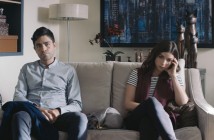
Editor’s Notes: Irish Screen America (ISA) is new organization formed to seek out and promote influential and emerging Irish talent to the U.S. and showcase the very best of contemporary Irish film, TV, animation, video games and interactive media. For more information visit www.irishscreenamerica.com.
Writer/director Frank Berry’s first narrative feature I Used to Live Here is full of more life than nearly all of this year’s major studio efforts, despite being much shorter in length and smaller in scale. A single frame from any scene can effortlessly communicate personalities and motivations to the viewer, and do so with gargantuan emotional integrity. Every scene means something, and every moment matters to the characters, which in turn makes those moments matter to us. Frank Berry treats these characters as real people with real insecurities, troubles, and unique demeanors, and his film is all the better for it.
Every scene means something, and every moment matters to the characters, which in turn makes those moments matter to us.

I Used to Live Here follows Amy Keane (Jordanne Jones), a vulnerable 13 year-old Irish girl who lives with her father and is dealing with the passing of her mother. She continues on living, going about her daily routine, bouncing between morose and content, when she receives the news that a friend of hers has committed suicide. As the town grieves in the wake of this tragedy, Amy begins making new friends. While this goes on, Amy’s father is approached by his old ex-girlfriend with some surprising news that inserts her into his and Amy’s life. Amy starts drifting deeper into sadness as these events progress, and she begins to contemplate suicide, or something similarly drastic.
The film chronicles Amy’s progression through these events, and displays both her changes and the changes of those around here with expert visual storytelling. This is valuable because at times, to an ear that doesn’t hail from Ireland, it can be difficult to understand some of the cast through their thick accents. Thankfully, the most important and telling lines in the film are delivered with lighter accents, and Frank Berry accommodates for the rest by doing his visual storytelling to perfection. Simply a facial expression or a gorgeous shot can convey the intricate emotional evolution each character goes through. Daragh O’Toole’s score lends to this in equal measure, allowing each scene it accompanies to feel incredibly poetic. In particular, the ending, which is played over a beautiful piece of music that’s been on my mind ever since I heard it.
As a narrative feature, it doesn’t allocate all focus to suicide itself, but rather the fragility of youth. Suicide, in the film, simply serves as a hammer to the glass.
What Frank Berry does best here is, without a doubt, the subtlety employed throughout the entire 80 minutes. We’ll often be introduced to a character nonchalantly going about their day, at their job or their school, as a new piece of information is introduced. Their reaction, and resulting emotional change, is what fuels the drama, not the information. It feels so true-to-life, so raw and real. So, it’s not surprising to learn that the film was originally intended to be a documentary about the ripple effects of suicide. As a narrative feature, it doesn’t allocate all focus to suicide itself, but rather the fragility of youth. Suicide, in the film, simply serves as a hammer to the glass.
Beautiful and harrowingly realistic in countless respects, both visually and thematically, I Used to Live Here is a pretty subtly heavy watch, but an incredibly rewarding and incredibly important one.
Beautiful and harrowingly realistic in countless respects, both visually and thematically, I Used to Live Here is a pretty subtly heavy watch, but an incredibly rewarding and incredibly important one.




Pingback: instagram free likes app()
Pingback: Manifestation Miracle Reviews()
Pingback: http://webifiedgames.com/index.php?task=profile&id=1746206()
Pingback: banheira()
Pingback: yspro.ne.jp()
Pingback: porno()
Pingback: click here to read()
Pingback: like it()
Pingback: look at this web-site()
Pingback: ecografe ieftine()
Pingback: Best buy bulk order smartphone accessories()
Pingback: curso de detetive profissional()
Pingback: paintless dent repair training()
Pingback: international kiss day()
Pingback: zubin medora()
Pingback: movie2k()
Pingback: bikinis()
Pingback: ramalan zodiak pisces()
Pingback: app developers uk()
Pingback: Rolando Niese()
Pingback: Brand Bangla Eshop()
Pingback: Meredith()
Pingback: happy valentines day wishes()